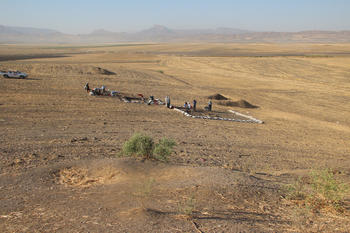Gird-i-Begum (Irakisch-Kurdistan)
Gird-i Begum (Iraqi Kurdistan)
Reinhard Bernbeck, Susan Pollock
In the summer of 2022 a team from Freie Universität Berlin, in cooperation with the Department of Antiquities in Sulaymaniyah, Iraq, began renewed excavations at the site of Gird-i Begum in the Shahrizor Plain. The site had been briefly investigated twice before, once by an Iraqi team in 1960 led by Muhammad Ali Mustafa and once in 2013 by the late Dr. Olivier Nieuwenhuyse, who had planned a long-term project at the site.
Gird-i Begum is approximately 5 ha in size and is composed of a high mound that reaches 20 meters above the level of the surrounding plain and an elongated lower mound that stretches to the south. The principal occupation of the site was in the Late Neolithic/Halaf and Chalcolithic (Ubaid and Late Chalcolithic) periods, that is from the late 6th through the mid-4th mill. BCE, although sporadic occupation in later times is also attested.
The current project seeks to investigate the settlement history of Gird-i Begum, subsistence practices, strategies of resource procurement and circulation, and changes in these practices and strategies over time. Special attention is devoted to the concept of mobility, in terms of the acquisition and circulation of materials, people, animals, plans, and ideas as well as spatial and temporal shifts in settlement. These investigations are embedded in a conceptual framework that seeks to understand the way in which past communities coped with potential crises instigated by sociocultural as well as physical-environmental conditions and interactions among them.
Gird-i Begum on Instragram:
https://www.instagram.com/girdi_begum/
---------------------------------------------------------------------------------------------------------------------------------------------------------------------
Gird-i Begum (Irakisch-Kurdistan)
Reinhard Bernbeck, Susan Pollock
Im Sommer 2022 begann ein Team der Freien Universität Berlin in Zusammenarbeit mit der irakischen Antikenbehörde in Sulaymaniyah mit Ausgrabungen am Gird-i Begum, einem Fundort in der Shahrizor-Ebene. Der antike Siedlungshügel war bereits zweimal kurz untersucht worden, einmal 1960 von einem irakischen Team unter Leitung von Muhammad Ali Mustafa und einmal 2013 von Dr. Olivier Nieuwenhuyse (†), der ein langfristiges Projekt in Begum geplant hatte, das er aber nicht mehr durchführen konnte.
Gird-i Begum hat eine Fläche von etwa 5 ha und besteht aus einem Haupthügel, der ca. 20 m über das Niveau der umgebenden Ebene hinausragt, und einer langgestreckten niedrigeren Erhebung, die sich nach Süden hin erstreckt. Die Hauptbesiedlung des Ortes datiert ins Spätneolithikum/ die Halaf-Zeit und das Chalkolithikum (Ubaid und Spätchalkolithikum), in absoluten Jahren vom späten 6. bis Mitte des 4. BCE, obwohl auch eine sporadische Besiedlung in späteren Zeiten belegt ist.
Im Rahmen des neuen Projekts sollen die Siedlungsgeschichte von Gird-i Begum, die Subsistenzpraktiken, die Strategien der Ressourcenbeschaffung und -zirkulation sowie die Veränderungen dieser Praktiken und Strategien im Laufe der Zeit untersucht werden. Besonderes Augenmerk liegt auf dem Konzept der Mobilität im Hinblick auf den Erwerb und die Zirkulation von Materialien, Menschen, Tieren, Pflanzen und Ideen sowie auf räumlichen und zeitlichen Verschiebungen der Besiedlung. Diese Untersuchungen sind in einen konzeptionellen Rahmen eingebettet, der zu verstehen sucht, wie prähistorische Gemeinschaften potenzielle Krisen bewältigten, die durch soziokulturelle bzw. physisch-ökologische Verhältnisse oder durch Interaktionen zwischen beiden ausgelöst wurden.
Gird-i Begum auf Instragram:
https://www.instagram.com/girdi_begum/



